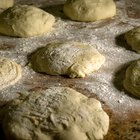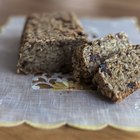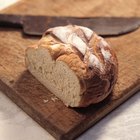Dense bread is the result of four possible agents: dead yeast due to water heat, not enough or damaged gluten, insufficient kneading or inadequate rising time. For bread made in a bread machine, the programs are set to mix, knead, rise and bake according to the selected recipe. But sometimes there are factors that a machine cannot detect. You can still use your bread machine, though if you desire fluffier bread, consider experimenting with a longer kneading or rising cycle on your machine, and add extra gluten to increase lightness.
Keep your wet ingredients cool. If you are proofing your yeast in water before adding it to your bread mixture, your recipe will call for “room temperature water.” If this is the case, make sure that it is room temperature, no more than 95 degrees. Hot water or hot milk will kill your yeast and not allow it to rise properly, thus leaving you with a dense bread.
Add a gluten enhancer. When baking with whole-wheat flour, the chances of your bread coming out dense increase significantly. Whole-wheat flour varies from all-purpose flour in that the bran is left on and ground in with the flour. The bran is very sharp (not to our eyes) and cuts into the gluten and breaks it down. Gluten is virtually the glue that keeps the bread together while allowing it to be light and airy. When the gluten is lower, the bread does not rise as well. For this reason, gluten-free flours and whole wheat breads are denser than fluffy white sandwich breads or crisp baguettes. To increase the gluten, whether you are using whole wheat or all purpose white flour, you can add gluten enhancers to alleviate denseness and give your bread a fluffier bounce.
Incorporate 1 tbsp. of either vital wheat gluten, vitamin C crystals or gluten flour into your dough. These products usually can be found in the baking or organic section of you grocery market.
Knead the dough properly and let it rise for a longer time. In traditional bread baking, the fluffiness is usually determined during the kneading stage. If you do not knead enough, your bread will be dense. Kneading releases the gluten and yeast which then form the air bubbles. These bubbles are the fluffy pockets that form to make the bread soft and airy. Oftentimes, bread machines do not knead or rise the dough long enough. If you machine has an option for extending the kneading or rising cycles, extend kneading by two to three minutes and rising by 30 minutes. Or, remove it and knead by hand on a floured surface for about three minutes. Remember, when you remove the dough from the machine, you are interrupting cycle. So know beforehand if your machine will pick back up where it left off, or if you will need to let it rise on its own and then bake in your conventional oven. Every bread machine is different; make sure you read the owner's manual thoroughly.
Related Articles

How to Use a Bread Machine to Make Dough

Why Bread Dough Does Not Rise

Gluten-Free Bread Without Eggs
How Long to Knead Bread Dough by Hand?
How to Make Homemade Bread

Can Fast Acting Yeast Be Used in Place ...

Why Does Bread Drop in the Middle When ...
Quick and Easy French Bread Recipe

How to Make Bread Chewy

How to Bake Bread in a Clay Pot

Can You Substitute Yogurt for Milk in ...

How to Make Dough in a KitchenAid Mixer
How to Make Bread That Does Not Crumble ...

How to Make Pumpkin Bread Moist

How Does a Bread Maker Work?

How to Make Hard Pretzels

Does Heat Kill Lactobacillus Bacteria ...

How to Bake Bread in a Dutch Oven

How to Make Bread Tender

How to Make Light Airy Italian Bread ...
References
Writer Bio
Mallory Ferland has been writing professionally since her start in 2009 as an editorial assistant for Idaho-based Premier Publishing. Her writing and photography have appeared in "Idaho Cuisine" magazine, "Spokane Sizzle" and various online publications. She graduated from Gonzaga University in 2009 with Bachelor of Arts degrees in history and French language and now writes, photographs and teaches English in Sao Paulo, Brazil.